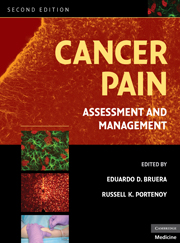Book contents
- Frontmatter
- Contents
- Contributors
- Preface
- SECTION I MECHANISMS AND EPIDEMIOLOGY
- SECTION II EPIDEMIOLOGY AND SYNDROMES
- SECTION III ASSESSMENT
- SECTION IV PHARMACOLOGICAL TREATMENT
- SECTION V OTHER INTERVENTIONAL STRATEGIES
- 16 Neural blockade for cancer pain
- 17 Neurosurgical treatment of cancer pain
- SECTION VI REHABILITATION AND PSYCHOLOGICAL INTERVENTIONS
- SECTION VII THE ROLE OF ANTINEOPLASTIC THERAPIES IN PAIN CONTROL
- SECTION VIII PAIN IN SPECIAL POPULATIONS
- SECTION IX DIFFICULT PAIN PROBLEMS
- SECTION X SYSTEMS OF CARE
- Index
- Plate section
- References
16 - Neural blockade for cancer pain
from SECTION V - OTHER INTERVENTIONAL STRATEGIES
Published online by Cambridge University Press: 06 July 2010
- Frontmatter
- Contents
- Contributors
- Preface
- SECTION I MECHANISMS AND EPIDEMIOLOGY
- SECTION II EPIDEMIOLOGY AND SYNDROMES
- SECTION III ASSESSMENT
- SECTION IV PHARMACOLOGICAL TREATMENT
- SECTION V OTHER INTERVENTIONAL STRATEGIES
- 16 Neural blockade for cancer pain
- 17 Neurosurgical treatment of cancer pain
- SECTION VI REHABILITATION AND PSYCHOLOGICAL INTERVENTIONS
- SECTION VII THE ROLE OF ANTINEOPLASTIC THERAPIES IN PAIN CONTROL
- SECTION VIII PAIN IN SPECIAL POPULATIONS
- SECTION IX DIFFICULT PAIN PROBLEMS
- SECTION X SYSTEMS OF CARE
- Index
- Plate section
- References
Summary
Background
Cancer pain is the result of cancer growth in human tissues, or the pain produced by any of the therapies implemented to treat it. The ideal management starts with a thorough assessment via history and physical examination, as well as the judicious use of diagnostic testing to try to define the pathophysiological components involved in the expression of pain to implement optimal analgesic therapy. Adequate pain control can be achieved in a majority of patients with the implementation of an aggressive pharmacological treatment with the use of opioids and adjuvants. With the implementation of these strategies, 90%–95% of patients may achieve adequate pain control. Consequently, 5%–10% of patients will need some form of invasive therapy. Thus, when following specific guidelines, a majority of patients with cancer-related pain may expect adequate pain control in the 21st century. Control of pain and its related symptoms is a cornerstone of cancer treatment, as it promotes an enhanced quality of life, improved functioning, better compliance, and a way for patients to focus on the things that give meaning to life. In addition to their salutary effects on quality of life, mounting evidence suggests that good pain control influences survival (see Table 16.1).
Classification of cancer pain
In the evaluation of a patient with cancer pain, it is important to obtain a history with the framework of four broad categories in mind: time course, intensity, pathophysiology, and the temporal aspect.
- Type
- Chapter
- Information
- Cancer PainAssessment and Management, pp. 315 - 328Publisher: Cambridge University PressPrint publication year: 2009



